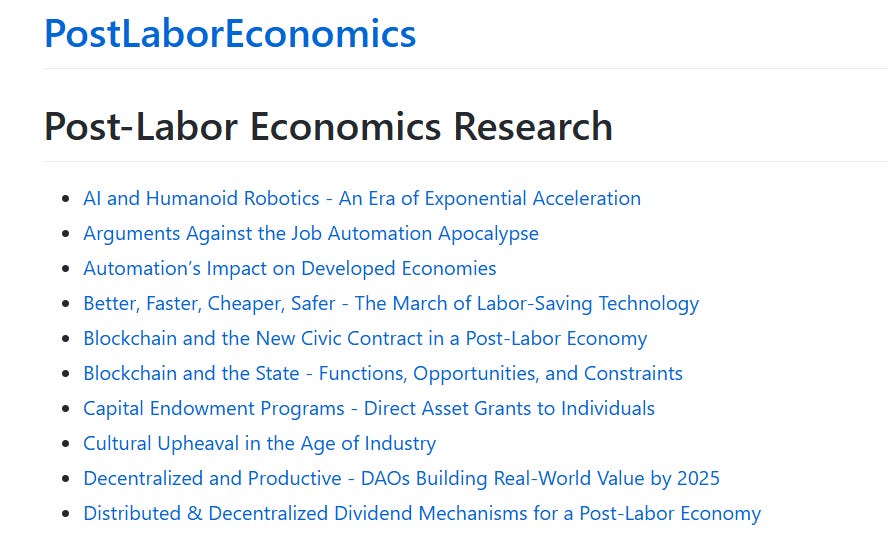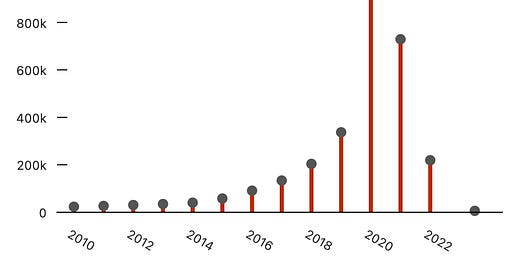The yapping will intensify until morale (never) improves
In the tech space, critics of influencers (often other influencers!) accuse many us of "yapping" - basically just talking to take up space and add noise. This is not our fault, it's the algorithm.
I’ve been hard at work compiling all my research on Post-Labor Economics. The good news is that, the more I look into this, the more I realize that the adults are talking, there are solutions, and we’re gonna be fine. Will we still have some rough patches ahead of us? Absolutely, but that’s life. My point is that the “AI and Robot Job Apocalypse” is coming, but it will not be as catastrophic as people fear.
You might then wonder, “why the hell haven’t I heard of all these magical solutions?”
Because solutions don’t sell. Not on social media algorithms, at least.

Lately, I use AI to glean the internet for feedback from my audience and detractors alike. The bigger you get, the more polarizing you become. You must take a stand on something, and in so doing, will inevitably piss off some people. Hell, just existing is enough to rankle half the planet, it seems.
On the positive side, I’ve learned that many of my ideas are resonating: “better, faster, cheaper, safer” has been adopted more widely in policy conversations from city councils up to Ivy League; the Economic Agency Index has struck a chord as something that is both measurable and actionable; the upcoming implosion of “KVM” (Keyboard, Video, Mouse” jobs is resonating.
On the flipside, plenty of people just don’t like me. I’m on extremely good terms with most of the other AI influencers and we all share stories about fans, weirdos, predatory advertisers, and everything else that comes with the life. That includes unfair criticism and misunderstandings. One of the things I learned very early on is that you need to repeat yourself for a long time to saturate the airwaves with what you actually think. Even when you do that, people will still misinterpret, misrepresent, and misread what you believe. It’s the weirdest thing. So you just shrug and move on with your day.

The good/bad news of the above graph is that it will be about 2043 until humanity has collectively built about one billion medium-duty humanoid robots. That means we have nearly 20 years until there will be 1 robot for every 10 humans (we will probably be closer to 10B global population by then).
This is “good news” insofar as we’re not going to see an immediate cascading shock of labor substitution. We will have time to adapt and we will see it coming.
This is “bad news” in that it will take a lot longer to reach a place of Fully Automated Luxury Space Communism than people would like.
When I first started sharing these robust numbers and models, some people were sad or disappointed, others were skeptical, and some became downright rabid. Insults bordering on threats, angry “unsubs” and other maligning of my name. Unfortunately, the public internet does not really want genuine thoughts, at times. At least the most vocal fringes. The mainstay of my audience appreciates my thoughts even if they disagree—it’s all food for thought. One perspective among many.
My incentive structure is a bit perverse at the moment. My personal livelihood comes from a combination of ad revenue (eyeballs), and subscribers (supportive fans). That means I need to optimize my content around what gets clicks and converts watchers to paying subs. Thus, I must strike a balance between hype, vibes, and real talk. Many people just want escapism, salvation fantasies, or excitement. That’s perfectly fine, I am totally down for that! I love making prediction videos and they are usually my top performing content.
But they don’t add anything substantive to the conversation.

We influencers, solopreneurs, and independent researchers are all obligated by the same incentive structures—go after that which gets you time, attention, and most importantly, money! Until we achieve a post-scarcity utopia, we’re all going to need to figure out a way to make ends meet.
Chase that bandwagon.
Fortunately, AI is getting the attention it needs and the space is broadening. Several big AI influencers reached out about burnout, since I’ve been quite vocal about my own struggles. Many of us feel like the “mainstream” AI conversation is getting boring. As one fellow YouTuber said “you can only talk about incremental improvements to tools so long before you get bored.” This has happened to me, too. I got bored of my GPT-3 prompting and finetuning tutorials so I pivoted to think-pieces and slide decks. Then, I got bored of my slide decks so I pivoted to Post-Labor Economics.
The underlying principle at work here is what I simply call saturation. The AI space is now saturated with voices. I think it may start to taper off soon. We’ve seen the same thing with podcasts and coaches.

Morale will never truly improve around AI. It will just fizzle out once we hit a point of technological diffusion. Once upon a time, electricity was a fascinating novelty. Now it is ubiquitous. That happened before anyone today was alive. What we do remember, however, was the rise of the internet, the rise of social media, and the rise of smartphones. Originally, AOL’s dialup jingle signified a new era. We got romcoms like You’ve Got Mail and Julie and Julia as the mainstream culture came to terms with online dating and the new “blogosphere.” Smartphones are unremarkable and even the mighty iPhone has lost its luster after several years of Apple’s stagnation.
Technological saturation, normalization, and diffusion occur, and then the noise tapers off. Instead of everyone talking about the latest shiny toy forever, they move on. Who knows what’s going to happen, exactly? No one, really, but history repeats itself. I probably won’t be an “AI influencer” forever. I’m actively diversifying my portfolio of revenue streams and focusing on the corner of AI that I really care about; the economic and social impact. Who knows? Maybe I’ll join or start a think tank one day.
Until then, I’ll leave you with one final visualization: an estimated count of the number of AI influencers over time.

Meanwhile, there are dozens of high-end economists focusing almost exclusively on post-labor economics broadly (the impact of AI and robotics and automation) and many thousands more in the policy space (think tanks, councilmembers, etc) who are concerned and starting to learn and take action.
The substance gets buried in the noise because of the algorithm, saturation, and a lowering signal-to-noise ratio. But rest assured, the substance is there, and it is growing.




You need your Engles. (Rich guy to pay the bills).
Your "Better, Faster, Cheaper, Safer" line is literally quoted in all my municipal presentations. I thoroughly enjoy reading everything you post on PLE. I always think back to the Will Smith movie "iRobot" when the screen opens to "2035" with robots and people rushing off to work or where ever. I always wondered where the people were rushing to in such large masses with the availability of such advanced robots. I have had a long standing question on PLE that keeps getting lost in the weeds, so I'll continue bringing it up until I get your take on it. How does a PLE future immunize itself against the corruption that is always inherent in politics? Pork lines the pockets and is plainly visible with every politician regardless of the side.